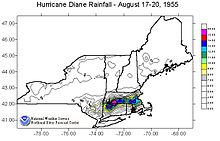Hurricane Diane
Gradually weakening after veering back west, Diane made landfall near Wilmington, North Carolina, as a strong tropical storm on August 17, just five days after Hurricane Connie struck near the same area.
Diane weakened further after moving inland, at which point the United States Weather Bureau noted a decreased threat of further destruction.
The storm turned to the northeast, and warm waters from the Atlantic Ocean helped produce record rainfall across the northeastern United States.
After the storm weakened in Virginia, it maintained an area of moisture that resulted in heavy rainfall after interacting with the Blue Ridge Mountains, a process known as orographic lift.
Diane produced heavy rainfall in eastern Pennsylvania, causing the worst floods on record there, largely in the Poconos and along the Delaware River.
Additional flooding spread through the northwest portion of neighboring New Jersey, forcing hundreds of people to evacuate and destroying several bridges, including one built in 1831.
In Massachusetts, flood water levels surpassed those during the 1938 New England Hurricane, breaching multiple dams and inundating adjacent towns and roads.
[3] By the time the Weather Bureau first classified the storm on August 10, Diane was south of the Bermuda high, a semi-permanent ridge in the jet stream just east of Nova Scotia.
[3] The intensification was so quick that a ship southeast of the center believed Diane was undergoing a loop due to a steady drop in barometric pressure, despite moving away from the hurricane.
[2] At its peak, Diane developed a well-defined eye about 30 mi (48 km) in diameter, described by reconnaissance aircraft as taking the shape of an "inverted teacup".
[4] Late on August 14, more than two days before Diane made landfall, the United States Weather Bureau issued a hurricane alert from Georgia through North Carolina.
The agency also issued storm warnings southward to Saint Augustine, Florida and northward to Atlantic City, New Jersey, including the Chesapeake and Delaware bays.
[9] The threat of the hurricane forced the planned retirement ceremony for Admiral Robert Carney to be transferred from an aircraft carrier in Norfolk, Virginia to an academy dormitory.
[8] Forecasters downplayed the threat of Diane after it weakened over Virginia;[12] the Weather Bureau agreed they did not foresee the extent of the rain that would occur, instead calling for just "some local flooding".
[13] The agency later admitted they "goofed" in downplaying the storm's destructive potential after weakening,[14] noting their lack of experience with extreme rainfall events.
[8] In the summer of 1955, the eastern United States experienced generally hot and dry weather, leading to drought conditions and decreased water levels.
[19] Hurricane Diane's path over the eastern United States brought heavy rainfall, fueled by unusually moist air resulting from abnormally high sea surface temperatures.
[2][9] The center of the storm passed over Wilmington without much of a decrease in winds, suggesting the eye had largely dissipated in the weakening tropical cyclone.
[8] High amounts of rainfall accrued in eastern Pennsylvania, peaking at 11.11 in (282 mm) in Pecks Pond in the northeast portion of the state.
[17] High levels along the Potomac River flooded low-lying portions of Virginia and Washington, D.C.[29] Wind gusts reached 62 mph (100 km/h) in Roanoke.
[8] The floods were the worst in record across eastern portions of the state, notably in the Poconos and along all tributaries of the Delaware River from Honesdale to Philadelphia.
Floods destroyed 17 bridges and 55 mi (89 km) of track along the Delaware, Lackawanna and Western Railroad, which is the primary rail line in northeastern Pennsylvania.
[21] In New Jersey, flooding largely occurred north of Trenton and west of Perth Amboy;[17] rainfall in the southern two–thirds of the state was less than 3 in (76 mm).
[31] All major streams and valleys were flooded during the storm, including hundreds of tributaries, and 30 gauges in the state reported the highest level on record.
[21] In Diane's immediate aftermath, one of the first priorities in response was to distribute adequate inoculations for typhoid amongst the widespread areas left without clean drinking water.
The American Red Cross quickly provided aid to the affected residents,[12] using churches and public buildings to house homeless people.
[41] The countries of Great Britain, Netherlands, Australia, Canada, France, Austria, and Venezuela offered aid to help the flood victims, sending emergency supplies.
[17] Following Diane, hundreds of companies affected by the flooding installed waterproof doors and windows to preempt similar disasters in the future.
[44] The Small Business Administration opened 18 temporary offices in the eastern United States for people to take out disaster loan applications.
[47] In 1956, the United States Congress passed the Federal Flood Insurance Act, but the program was not enacted due to lack of funding.

Tropical storm (39–73 mph, 63–118 km/h)
Category 1 (74–95 mph, 119–153 km/h)
Category 2 (96–110 mph, 154–177 km/h)
Category 3 (111–129 mph, 178–208 km/h)
Category 4 (130–156 mph, 209–251 km/h)
Category 5 (≥157 mph, ≥252 km/h)
Unknown



